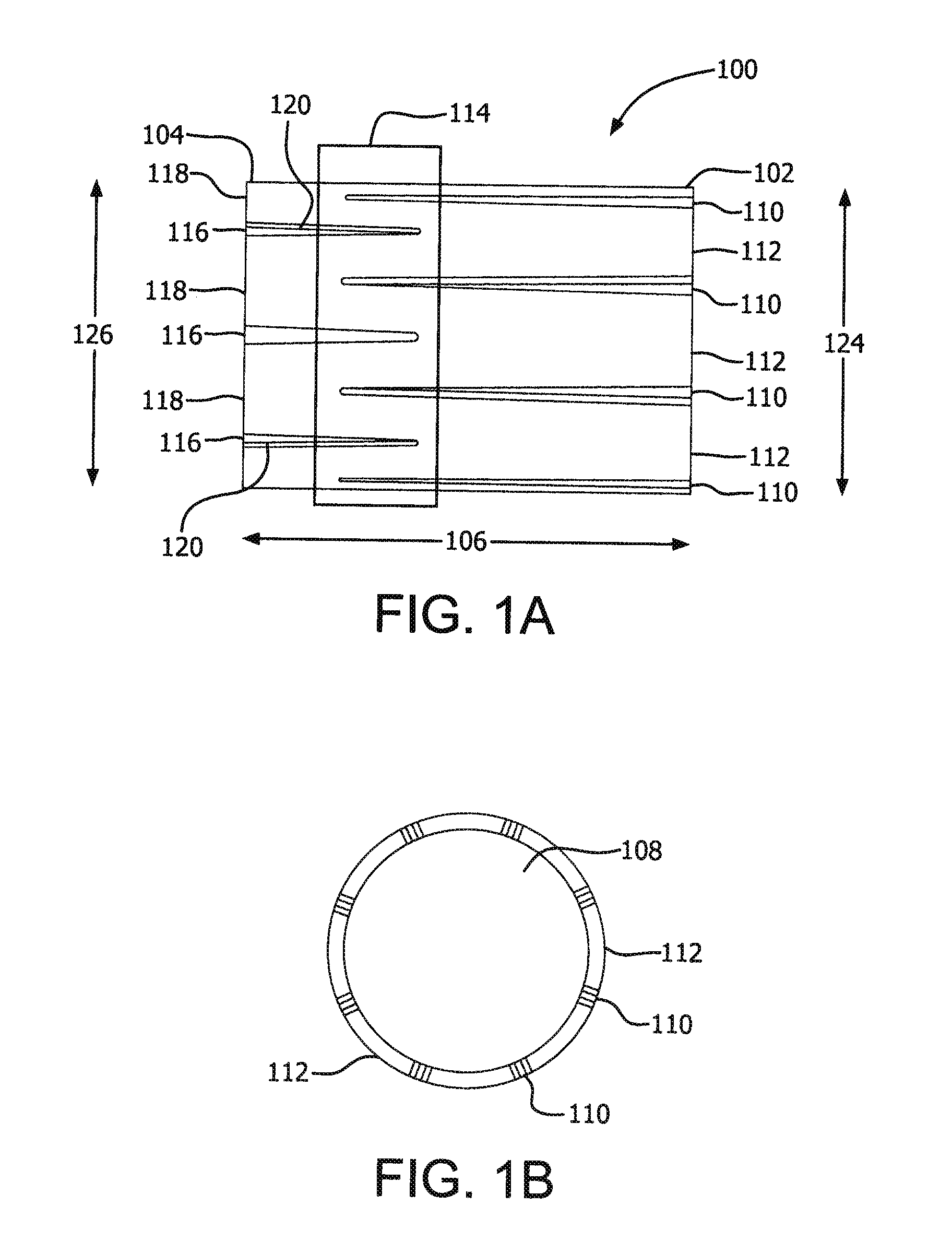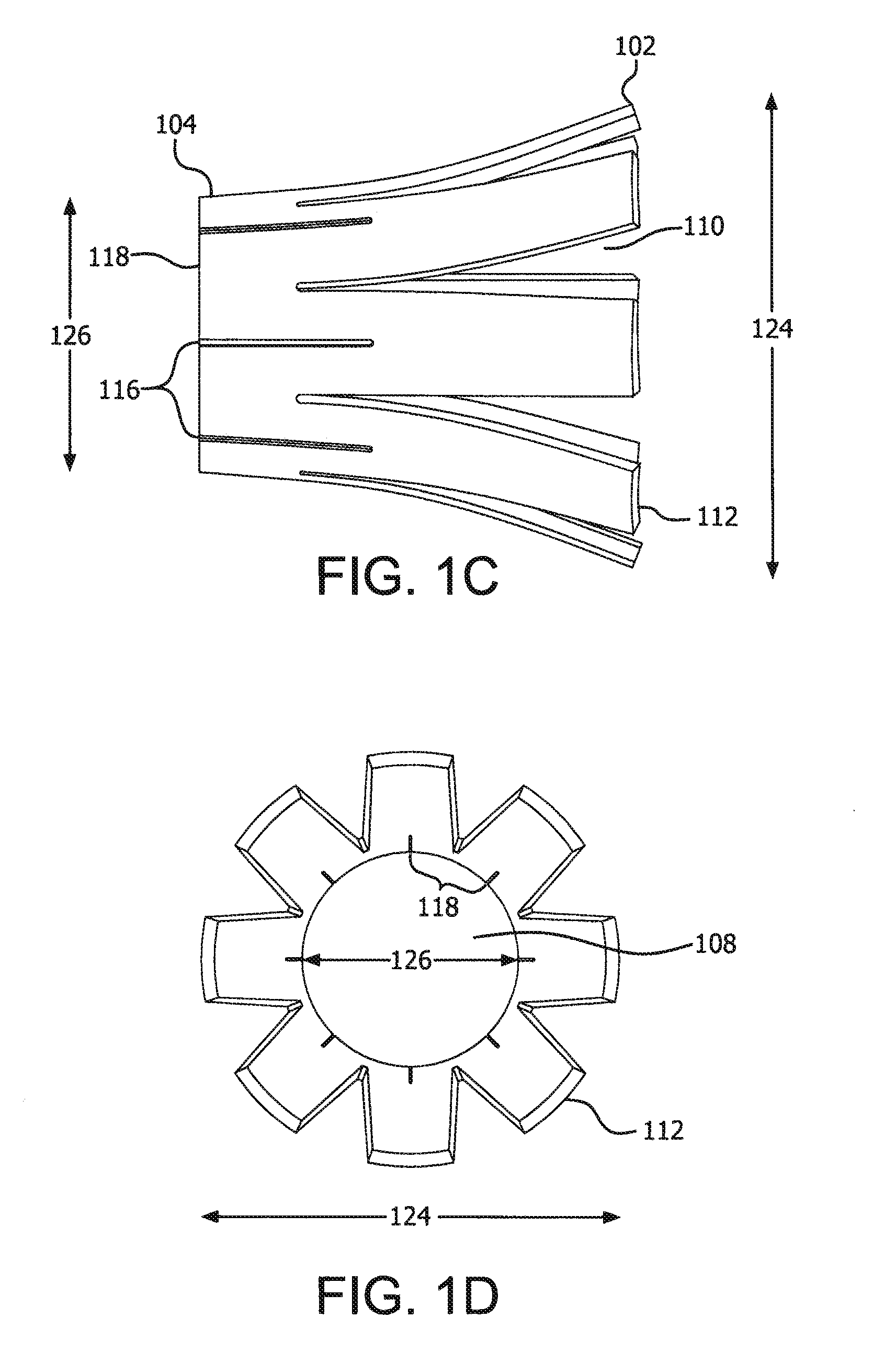Pivoting ring seal
a ring seal and ring technology, applied in the field of medical procedures, can solve the problems of prolonging the time and risks of the procedure, increasing the cost of the procedure, injury or death of the patient, etc., and achieve the effect of preventing leakage or failure, increasing inflation and/or expansion
- Summary
- Abstract
- Description
- Claims
- Application Information
AI Technical Summary
Benefits of technology
Problems solved by technology
Method used
Image
Examples
example 1
Constructing Pivot Ring
[0075]A pivot ring was made by cutting the pattern illustrated in FIG. 5 into a nitinol tube with an outside diameter of 0.086″ and inside diameter of 0.074″. For ease of illustration, FIG. 5 depicts the flat pattern that was cut into the tube. The cut pattern provided for 8 slots in clamping side 504 of the ring with widths of 0.004″ each. Fully closed, this would result in roughly a 0.064″ diameter or a 0.010″ reduction in inside diameter. The cut utilized a staggered orientation of opening slits 502 and clamping slots with roughly a 2:1 length ratio (opening finger length:closing finger length). FIG. 5B is shown as tubular depiction of the resulting band.
example 2
Constructing a Balloon Catheter
[0076]EPTFE balloon construct was made according to the teachings of U.S. Pat. No. 6,923,827, Campbell, et al. Forty layers of ePTFE were wrapped around a 6 mm mandrel at a high angle and in opposing directions. This tube was heated at 380° C. for approximately 8 minutes to fuse the layers together. The tube was removed from the mandrel and stretched which resulted in a reduction in inside diameter to at least below 0.075″. The tubing was then slid onto a 0.075″ stainless steel mandrel. A sacrificial overwrap of ePTFE film was placed over the tubing and its length was evenly reduced to 60% of its original length. The tube was heated at 380° C. for one minute and the sacrificial ePTFE was removed. This ePTFE tube was dipped into a 12% solution of Biospan polyurethane (DSM, Netherlands) in DMAC (N,N Dimethylacetamide). Three dips were made into the solution with a heat / drying step between each step to dry off the solvent. This tube was removed from the m...
example 3
Illustration of Pivot Ring on a Balloon Catheter
[0078]The catheter construct of Example 2 was inflated to 6 atm's with the band in a location approximately 28 mm from the proximal seal (FIG. 6A). This resulted in a total inflated length of roughly 28 mm and no inflation media was observed passing underneath the pivoting ring member. The balloon was deflated (FIG. 6B) and the ring was repositioned distally about 10 mm (as depicted by arrow 615 in FIG. 6C). The balloon was reinflated to 8 atm's and the new inflated length of the balloon was about 38 mm (FIG. 6D) and again, no inflation media was observed passing underneath the pivoting ring. A closer image of the pivot band in its pivoted state (FIG. 7, with reference numbers as described in FIG. 1) is shown to demonstrate the band embedding into the balloon construct to make a seal and prevent axial migration upon inflation.
PUM
 Login to View More
Login to View More Abstract
Description
Claims
Application Information
 Login to View More
Login to View More - R&D
- Intellectual Property
- Life Sciences
- Materials
- Tech Scout
- Unparalleled Data Quality
- Higher Quality Content
- 60% Fewer Hallucinations
Browse by: Latest US Patents, China's latest patents, Technical Efficacy Thesaurus, Application Domain, Technology Topic, Popular Technical Reports.
© 2025 PatSnap. All rights reserved.Legal|Privacy policy|Modern Slavery Act Transparency Statement|Sitemap|About US| Contact US: help@patsnap.com



